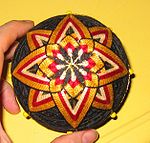
Temari (toy)
Encyclopedia

Folk art
Folk art encompasses art produced from an indigenous culture or by peasants or other laboring tradespeople. In contrast to fine art, folk art is primarily utilitarian and decorative rather than purely aesthetic....
form that originated in China and was introduced to Japan five or six hundred years ago. "Temari" means "hand ball" in Japanese
Japanese language
is a language spoken by over 130 million people in Japan and in Japanese emigrant communities. It is a member of the Japonic language family, which has a number of proposed relationships with other languages, none of which has gained wide acceptance among historical linguists .Japanese is an...
. Embroidered balls may be used in hand ball games.
History
Historically, temari were constructed from the remnants of old kimonoKimono
The is a Japanese traditional garment worn by men, women and children. The word "kimono", which literally means a "thing to wear" , has come to denote these full-length robes...
s. Pieces of silk
Silk
Silk is a natural protein fiber, some forms of which can be woven into textiles. The best-known type of silk is obtained from the cocoons of the larvae of the mulberry silkworm Bombyx mori reared in captivity...
fabric would be wadded up to form a ball, and then the wad would be wrapped with strips of fabric. As time passed, traditional temari became an art, with the functional stitching becoming more decorative and detailed, until the balls displayed intricate embroidery
Embroidery
Embroidery is the art or handicraft of decorating fabric or other materials with needle and thread or yarn. Embroidery may also incorporate other materials such as metal strips, pearls, beads, quills, and sequins....
. With the introduction of rubber
Rubber
Natural rubber, also called India rubber or caoutchouc, is an elastomer that was originally derived from latex, a milky colloid produced by some plants. The plants would be ‘tapped’, that is, an incision made into the bark of the tree and the sticky, milk colored latex sap collected and refined...
to Japan, the balls went from play toys to art objects, although mothers still make them for their children. Temari became an art and craft of the Japanese upper class and aristocracy, and noble women competed in creating increasingly beautiful and intricate objects.
Tradition
Temari are highly valued and cherished gifts, symbolizing deep friendship and loyalty. Also, the brilliant colors and threads used are symbolic of wishing the recipient a brilliant and happy life. Traditionally, becoming a craftsman in Japan was a tedious process. Becoming a temari artist in Japan today requires specific training, and one must be tested on one's skills and technique before being acknowledged as a crafter of temari.Traditionally, temari were often given to children from their parents on New Year's Day. Inside the tightly wrapped layers of each ball, the mother would have placed a small piece of paper with a goodwill wish for her child. The child would never be told what wish his or her mother had made while making the ball.
Alternately, some balls contained "noisemakers" consisting of rice grains or bells to add to the play value. It is said that traditional temari were wrapped so tightly they would bounce.
Temari are also known as "gotenmari."
External links
- http://www.japanesetemari.com
- http://www.temarichallengegallery.org
- http://temarikai.com/
- http://temari.com/
- http://web.archive.org/web/20091028083205/http://geocities.com/clairecassan/Temari.html

